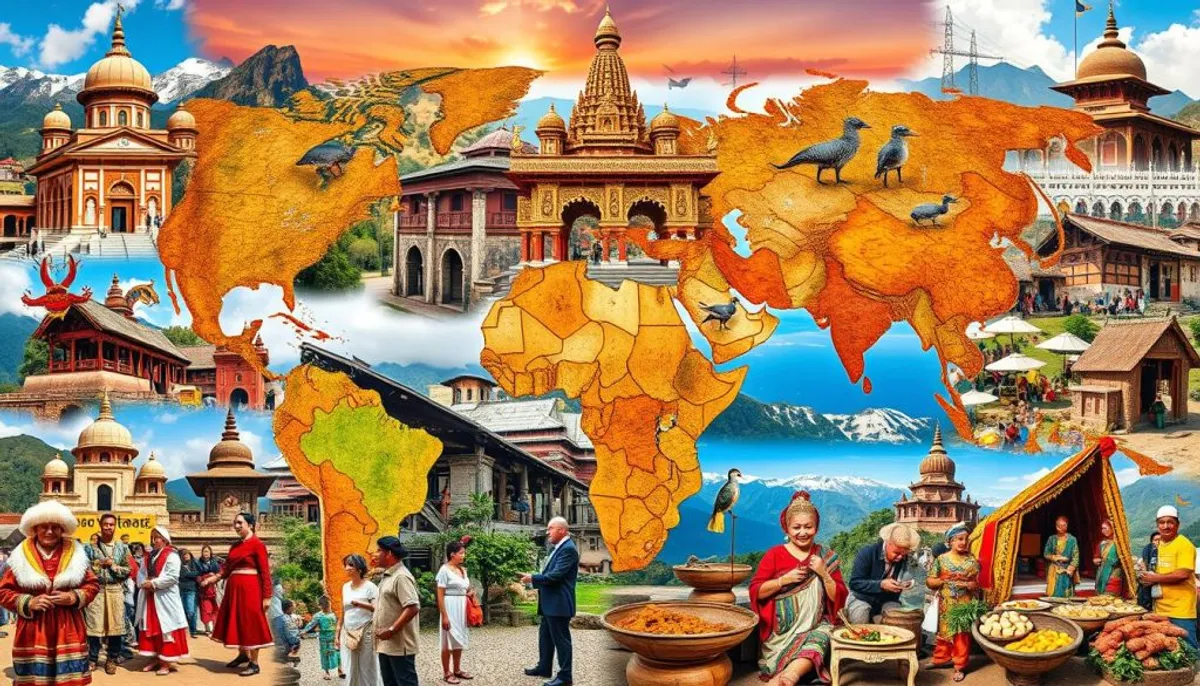The cultural diversity is a valuable asset for our humanity. It unfolds through our traditions, customs, and ways of life. In the era of globalization, understanding these variations is essential for harmonious interaction with others.
When traveling abroad, one discovers fascinating nuances. In France, kisses are a common gesture, while bowing is a sign of respect in Japan. These simple practices highlight the depth of intercultural exchanges.

Cultural differences are also manifested in our daily routines, particularly through Vietnamese customs. For example, in France, pedestrians have the right of way, unlike in some Asian countries where pedestrian bridges are the norm.
The globalization, while bringing cultures closer together, does not homogenize them. It allows us to exchange and learn from each other while preserving our distinct identities. Exploring these differences opens us to a universe of captivating discoveries.
The foundations of global cultural diversity
Cultural diversity is an essential pillar of our globalized society. Cultural identity is forged through multiple facets, encompassing language, traditions, and customs unique to each community. These unique cultural traits contribute to the richness of the world heritage.
Culture as a pillar of social identity
Culture plays a crucial role in building social identity. It influences our behaviors, values, and perception of the world. Intercultural exchanges, fostered by globalization, allow for better understanding between peoples.
The objective and subjective dimensions of culture
Culture manifests itself in both tangible and intangible ways. Objective aspects include art, cuisine, and clothing styles. Subjective elements encompass beliefs, values, and social norms. This duality enriches interactions between different communities.
The impact of globalization on cultural exchanges
Globalization has accelerated intercultural exchanges, creating new dynamics. According to UNESCO, 185 countries have signed a convention to protect cultural diversity. However, this phenomenon raises challenges. More than 200 African languages have fewer than 500 speakers, and 50% to 90% of current languages risk disappearing this century.
Companies recognize the importance of cultural diversity. For example, Google offers its services in 4,000 languages, reflecting its commitment to global cultural plurality. This inclusive approach fosters innovation and creativity in an increasingly interconnected world.
Communication and intercultural interactions
Intercultural communication is an essential foundation in our globalized world. It involves exchanges between individuals from diverse cultures, each bringing their own perspectives and modes of expression. This complex interaction is crucial for developing harmonious and respectful relationships.
Explicit and implicit communication styles
Cultures differ in their ways of communicating. For example, the United States and Germany favor direct and clear communication. In contrast, Japan and China value harmony and subtlety. This cultural diversity can lead to misunderstandings if not understood and respected.
Non-verbal language across cultures
Non-verbal language is essential in intercultural communication. Gestures, facial expressions, and postures vary significantly from one culture to another. For example, direct eye contact, appreciated in the West, may be perceived as disrespectful in some Asian cultures.

The management of interpersonal space according to cultures
Proxemics, a concept developed by Edward T. Hall, reveals cultural differences in managing personal space. In Latin America and the Middle East, people generally stand closer to one another than in Nordic countries. These variations can create discomfort during intercultural interactions if not anticipated.
| Culture | Communication Style | Interpersonal Distance |
|---|---|---|
| United States | Explicit | Medium |
| Japan | Implicit | Large |
| Brazil | Mixed | Short |
Understanding these cultural nuances is essential to avoid misunderstandings and foster enriching intercultural exchanges. Active listening, careful observation, and adaptability are key skills for effectively navigating the complex landscape of intercultural communication.
Cultural comparison: ways of life and traditions
Cultural differences reveal themselves in our everyday habits, showcasing the diversity of traditions around the globe. For example, the way cultures interpret animal sounds is fascinating. In France, a dog says "Ouaf," whereas in Germany it says "Wuff." In China, it is "Wang," and in Spain, "Guau."
Reactions to sneezing also reflect these differences. The French say "Atchoum," Germans say "Hatschi," the Chinese say "Ah-ti," and the Spanish say "Achis." These linguistic variations highlight the diversity of cultural expressions in our daily lives.

Cultural traditions influence our perception of time and our organization. Monochronic cultures, like the German, prioritize completing one task at a time, with strict adherence to deadlines. In contrast, polychronic cultures, such as French or Italian, adopt a more flexible approach, seamlessly chaining tasks together.
These cultural differences also manifest in professional practices. In some cultures, respect for elders is paramount during meetings, while others value social equality, allowing everyone to express themselves regardless of their hierarchical position.
Traveling is essential for understanding these cultural differences. It allows us to observe and appreciate the diversity of ways of life and traditions. At the same time, it prompts us to reflect on our own culture.
Time management and decision-making
Time management and decision-making vary significantly across cultures. These differences profoundly impact the functioning of businesses and professional relationships on a global scale.
Monochronic vs. polychronic cultures
Monochronic cultures, like Germany, value punctuality and strict organization. In contrast, polychronic cultures, such as France or Italy, adopt a more flexible approach to time. For example, 65% of French people have asked a colleague to be quieter in an open space, illustrating a different management of work space and time.
Hierarchy and decision-making processes
Cultural hierarchy strongly influences decision-making processes. In Japan, hierarchy is paramount, while Nordic countries prioritize equality. A study by Steelcase reveals that the French have a low tolerance for hierarchical relationships, impacting their approach to decision-making in business.
The impact of societal values on management
Societal values shape managerial practices. French managers tend to deliberate extensively before deciding, unlike Quebecois and Moroccans who opt for quick implementation. This diversity of approaches highlights the importance of understanding cultural nuances in international management.
Globalization promotes a certain standardization of management methods, but cultural differences remain a valuable asset in business. Multiculturalism is now seen as an advantage, enriching perspectives and improving collective decision-making through active listening.
Differences in professional practices
Professional practices vary significantly from country to country, reflecting the diversity of work cultures around the world. This cultural richness profoundly influences intercultural management and international collaboration.
Approaches to work according to cultures
In France, the 35-hour workweek is strictly respected, offering employees numerous holidays and benefits. In contrast, in the United States, workdays are often longer with fewer vacations. American culture values individual performance and encourages direct communication. In Japan, the pursuit of consensus is paramount, which can slow down decision-making.
Hierarchical relationships and collaboration
Hierarchical relationships differ by country. In East Asia, respect for authority and seniority is deeply ingrained. In contrast, Scandinavian countries like Sweden prioritize a balance between work and personal life. These cultural differences influence international collaboration and require an adaptation of intercultural management.
Managing intercultural conflicts
Conflict resolution in a multicultural context is a major challenge. A study conducted with 24 social educators revealed three approaches to managing cultural differences: a uniform intervention, an individualized approach, or an adaptation to cultural specifics. When well-managed, cultural diversity can stimulate innovation and improve the performance of international teams.
RelatedRelated articles


